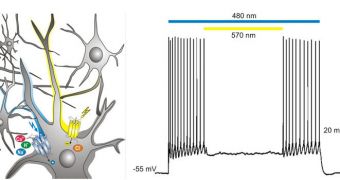A group of scientists has recently discovered one of the first naturally-occurring, light-activate ion channels in the human body. Finding these channels is extremely important for medicine, biosciences and biotechnology, as they could allow for the development of treatments for a wide array of conditions. Neuroscientists have been looking for methods of engineering nerve cells that can respond to light stimuli for many years, but thus far their efforts have been inconclusive, PhysOrg reports.
Now, investigator Ernst Bamberg, the director of the Max Planck Institute of Biophysics, together with scientists Georg Nagel (Wurzburg University) and Peter Hegemann (Humboldt University Berlin), take new steps in the right direction. The group managed to discover channelrhodopsins, which is basically a family of ion channels occurring in the body that can be activated by the presence of a certain kind of light. For their remarkable finding, they have been awarded the 2010 Wiley Prize for Biomedical Sciences, which they will receive on April 9, during a ceremony to be held in New York City, US.
Using precisely this class of channels, the scientific community was able to create the new research field called optogenetics, which deals with how nerve cells function within living animals. Additionally, they discovery also permitted the development of better lab methods for tracking the activity of neural cells and networks inside cultures, kept in the tightly-controlled confines of scientific laboratories. Using light rather than electrodes for turning cells on and off is both more elegant and precise, scientist say, and allows for a greater degree of accuracy in investigations.
“Optogenetics is currently revolutionizing neuro- and cell-biological research. Now for the first time, without electrodes or any chemical modification, we can easily use light to control the activity of neurons and muscle cells, reliably and with a high spatial resolution that has never been achieved before,” explains Ernst Bamberg. The light-activated channels were discovered in 2002 and 2003. The finding came as a huge shock, as no other group had even hinted at their existence before.

 14 DAY TRIAL //
14 DAY TRIAL //